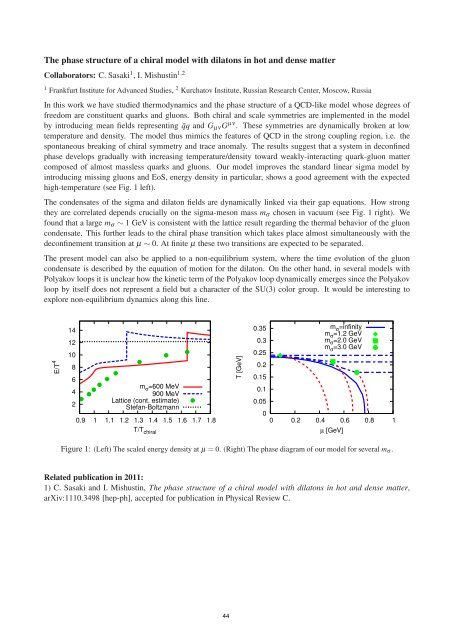FIAS Scientific Report 2011 - Frankfurt Institute for Advanced Studies ...
FIAS Scientific Report 2011 - Frankfurt Institute for Advanced Studies ...
FIAS Scientific Report 2011 - Frankfurt Institute for Advanced Studies ...
Create successful ePaper yourself
Turn your PDF publications into a flip-book with our unique Google optimized e-Paper software.
The phase structure of a chiral model with dilatons in hot and dense matter<br />
Collaborators: C. Sasaki 1 , I. Mishustin 1,2<br />
1 <strong>Frankfurt</strong> <strong>Institute</strong> <strong>for</strong> <strong>Advanced</strong> <strong>Studies</strong>, 2 Kurchatov <strong>Institute</strong>, Russian Research Center, Moscow, Russia<br />
In this work we have studied thermodynamics and the phase structure of a QCD-like model whose degrees of<br />
freedom are constituent quarks and gluons. Both chiral and scale symmetries are implemented in the model<br />
by introducing mean fields representing ¯qq and GµνG µν . These symmetries are dynamically broken at low<br />
temperature and density. The model thus mimics the features of QCD in the strong coupling region, i.e. the<br />
spontaneous breaking of chiral symmetry and trace anomaly. The results suggest that a system in deconfined<br />
phase develops gradually with increasing temperature/density toward weakly-interacting quark-gluon matter<br />
composed of almost massless quarks and gluons. Our model improves the standard linear sigma model by<br />
introducing missing gluons and EoS, energy density in particular, shows a good agreement with the expected<br />
high-temperature (see Fig. 1 left).<br />
The condensates of the sigma and dilaton fields are dynamically linked via their gap equations. How strong<br />
they are correlated depends crucially on the sigma-meson mass mσ chosen in vacuum (see Fig. 1 right). We<br />
found that a large mσ∼ 1 GeV is consistent with the lattice result regarding the thermal behavior of the gluon<br />
condensate. This further leads to the chiral phase transition which takes place almost simultaneously with the<br />
deconfinement transition at µ∼ 0. At finite µ these two transitions are expected to be separated.<br />
The present model can also be applied to a non-equilibrium system, where the time evolution of the gluon<br />
condensate is described by the equation of motion <strong>for</strong> the dilaton. On the other hand, in several models with<br />
Polyakov loops it is unclear how the kinetic term of the Polyakov loop dynamically emerges since the Polyakov<br />
loop by itself does not represent a field but a character of the SU(3) color group. It would be interesting to<br />
explore non-equilibrium dynamics along this line.<br />
E/T 4<br />
14<br />
12<br />
10<br />
8<br />
6<br />
4<br />
2<br />
m σ =600 MeV<br />
900 MeV<br />
Lattice (cont. estimate)<br />
Stefan-Boltzmann<br />
0.9 1 1.1 1.2 1.3 1.4 1.5 1.6 1.7 1.8<br />
T/Tchiral T [GeV]<br />
0.35<br />
0.3<br />
0.25<br />
0.2<br />
0.15<br />
0.1<br />
0.05<br />
m σ =infinity<br />
m σ =1.2 GeV<br />
m σ =2.0 GeV<br />
m σ =3.0 GeV<br />
0<br />
0 0.2 0.4 0.6 0.8 1<br />
µ [GeV]<br />
Figure 1: (Left) The scaled energy density at µ = 0. (Right) The phase diagram of our model <strong>for</strong> several mσ .<br />
Related publication in <strong>2011</strong>:<br />
1) C. Sasaki and I. Mishustin, The phase structure of a chiral model with dilatons in hot and dense matter,<br />
arXiv:1110.3498 [hep-ph], accepted <strong>for</strong> publication in Physical Review C.<br />
44
















